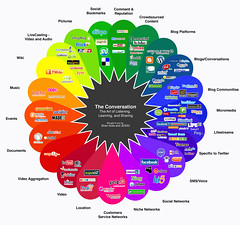|

Folksonomy
Folksonomy (also known as collaborative tagging, social classification, social indexing,
and social tagging) is the practice and method of collaboratively creating and managing tags to annotate and categorizecontent.
Folksonomy describes the bottom-up classification systems that emerge from social tagging.[1]
In contrast to traditional subject indexing,
metadata is generated not only by experts but also by creators and consumers of the
content.
Usually, freely chosen keywords are used instead of a controlled vocabulary.[2]
Folksonomy (a portmanteau of folk + taxonomy) is a user-generated taxonomy.
http://en.wikipedia.org/wiki/Folksonomy
----------------------------------------------------------------------------------
|
----
|
What is MrTaggy?
MrTaggy is an experiment in web search and exploration built on top of a PARC algorithm called TagSearch. Think of MrTaggy as a cross between a search engine and a recommendation engine: it’s a web browsing guide constructed from social tagging data.
Unlike most search engines, MrTaggy doesn’t index the text on a web page. Instead, it leverages the knowledge contained in the tags that people add to web pages when using social bookmarking services.
Tags describe both the content and context of a web page, and we use that information to deliver relevant search results.
The problem with using social tags is that they contain a lot of noise, because people often use different words to mean the same thing or the same words to mean different things.
The TagSearch algorithm is part of our ongoing research to reduce the noise while amplifying the information signal from social tags.
We also designed a novel search UI to explore the tag space. The Related Tags sidebar outlines the content landscape to help you understand the space. The relevance feedback capabilities enable you to tell the system both positive and negative cues about directions where you want to go. Try clicking on the Thumbs Up and Down to give feedback to MrTaggy about the tags or results that you liked, and see how your rating changes the result set on-the-fly.
|
-------- |
Search Wikipedia with WikiDashboard
We are pleased to announce the release of our first research prototype of a social dynamic analysis tool for Wikipedia called WikiDashboard.
The idea is that if we provide social transparency and enable attribution of work to individual workers in Wikipedia, then this will eventually result in increased credibility and trust in the page content, and therefore higher levels of trust in Wikipedia.
Wikipedia itself keeps track of these studies and openly discusses them here, which is a form of social transparency itself.
However, even Wales himself have been quoted as saying that "while Wikipedia is useful for many things, he would like to make it known that he does not recommend it to college students for serious research." Indeed, the standard complaint I often hear about Wikipedia is that because of its editorial policy (anyone can edit anything), it is an unreliable source of information.
-------------------------------------------------------------------------------------------
|
-- ------- |
THE FUTURE OF WEB SEARCH
Semantic search is a process used to improve online searching by using data from semantic networks to disambiguate queries and web text in order to generate more relevant results. Hildebrand et al. [1] provide an overview that lists semantic search systems and identifies other uses of semantics in the search process.
Guha et al.[2] distinguish two major forms of search: Navigational and Research. In navigational search, the user is using the search engine as a navigation tool to navigate to a particular intended document. Semantic Search is not applicable to navigational searches. In Research Search, the user provides the search engine with a phrase which is intended to denote an object about which the user is trying to gather/research information. There is no particular document which the user knows about that s/he is trying to get to. Rather, the user is trying to locate a number of documents which together will give him/her the information s/he is trying to find. Semantic Search lends itself well here.
Rather than use ranking algorithms such as Google's PageRank to predict relevancy, Semantic Search uses semantics, or the science of meaning in language to produce highly relevant search results. In most cases, the goal is to deliver the information queried by a user rather than have a user sort through a list of loosely related keyword results.
Other authors primarily regard semantic search as a set of techniques for retrieving knowledge from richly structured data sources like ontologies as found on the Semantic Web [3]. Such technologies enable the formal articulation of domain knowledge at a high level of expressiveness and could enable the user to specify his intent in more detail at query time.
|
Comments (0)
You don't have permission to comment on this page.